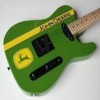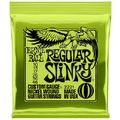What microphone should I look at
Page 2 of 2: 12

Member
Posts: 35
Joined: 28 mag 2015
Hey TG - I have owned and used a Shure M58 for over 20 years. it has never failed me, and many many musicians use this mic. cost is under $100.

Member
Posts: 52
Joined: 28 gen 2012
A Shure SM58 is really good for live performance, but some sort of condensor mic ( usually requires phantom power on your usb interface ) would work better for indoor home recording. The Sm58 sometimes is ideal for recording a guitar amp.

Ernie Ball 2221 Regular Slinky Gitarrensaiten
Saitensatz für E-Gitarre

5,90 €
iThis widget links to Thomann, our affiliate partner. We may receive a commission when you purchase a product there.
Visit Shop
Member
Posts: 374
Joined: 25 mar 2012
Slimdaver wrote:
A Shure SM58 is really good for live performance, but some sort of dynamic mic ( usually requires phantom power on your usb interface ) would work better for indoor home recording. The Sm58 sometimes is ideal for recording a guitar amp.
A Shure SM58 is really good for live performance, but some sort of dynamic mic ( usually requires phantom power on your usb interface ) would work better for indoor home recording. The Sm58 sometimes is ideal for recording a guitar amp.
A SM58 is dynamic.. I think you mean a condensor mic, they need phantom power

Member
Posts: 52
Joined: 28 gen 2012
nilton wrote:
A SM58 is dynamic.. I think you mean a condensor mic, they need phantom power
A SM58 is dynamic.. I think you mean a condensor mic, they need phantom power
Thanks nilton. I edited my post so it shows correct type of mic.
SUPPORTER
Posts: 90
Joined: 4 lug 2014
Hello, I'm not an expert in vocal recording, I only did this once recently, but I did some reading on the internet and consulted some more experienced guys.
On the microphone: What I remember on de D310 that it's described as a microphone introduced for to be used for backing vocals. Lead vocals asked more for the D320 or 330 if I recall correctly. It has some attenuator switches and probably a bit different pickup zone characteristics. But like the SM58 and probably most of the suggested mikes they are aiming for amplification use like in PA systems. The SM59 is famous as a stage mike because it probably survives all falling accidents. So even severly dented they will likely continue to work. Some even claim that it can be used as a hammer if you need one building the stage...
For the use in recording mostly more fragile microphones are used, bigger membranes and mostly condensator. They pick up very much sound so a good quiet place is needed. Or you might hear the neighbours dog breath.
But for most Wikiloops situation probably the mentioned stage mikes can do the job sufficiently. It's a matter of good usage of the tools you've got. My first and only voice recording so far was done with the earlier mentioned Shure SM58. As I believe it is safe in this environment, and if you are interested (it is not me singing) you can listen to it on [url=http://gijs.mrbasic.com/images/audio/Bougainville%203.mp3] HERE [/url].
Technical advice: don't sing straight into the microphone to avoid hearing the popping and breathing noises. Just aim right beside (under or above) your mouth. Maybe some signal optimising can be done afterwards, to bring the levels more closer to the 0 dB border. But yo give the recorded vocal some punch in the mix you need some good compression (hardware or plugin). But when vocals are compressed then everything get's that punch. That sounds not natural. For instance your S sounds don't get evenly more louder than your vowels when raising your voice. So before the compression you need to lower those sounds. And there comes the de-esser. This combination (first de-essing and then compression) will give your vocals more punch and clarity in the mix. There are some plugins that promis to do both jobs in one plugin
But always try to optimize your recordinglevels to get the best possible recording with the material you've got. Remember rubbish in is rubbish out... Besides this de-essing and compression other effects like equalising, delays or more exotics can be used afterwards to match your mix even more.
I hope this is usefull in your quest for voice recording. And if there are other opinions I'm still learning and interested in those too.
On the microphone: What I remember on de D310 that it's described as a microphone introduced for to be used for backing vocals. Lead vocals asked more for the D320 or 330 if I recall correctly. It has some attenuator switches and probably a bit different pickup zone characteristics. But like the SM58 and probably most of the suggested mikes they are aiming for amplification use like in PA systems. The SM59 is famous as a stage mike because it probably survives all falling accidents. So even severly dented they will likely continue to work. Some even claim that it can be used as a hammer if you need one building the stage...
For the use in recording mostly more fragile microphones are used, bigger membranes and mostly condensator. They pick up very much sound so a good quiet place is needed. Or you might hear the neighbours dog breath.
But for most Wikiloops situation probably the mentioned stage mikes can do the job sufficiently. It's a matter of good usage of the tools you've got. My first and only voice recording so far was done with the earlier mentioned Shure SM58. As I believe it is safe in this environment, and if you are interested (it is not me singing) you can listen to it on [url=http://gijs.mrbasic.com/images/audio/Bougainville%203.mp3] HERE [/url].
Technical advice: don't sing straight into the microphone to avoid hearing the popping and breathing noises. Just aim right beside (under or above) your mouth. Maybe some signal optimising can be done afterwards, to bring the levels more closer to the 0 dB border. But yo give the recorded vocal some punch in the mix you need some good compression (hardware or plugin). But when vocals are compressed then everything get's that punch. That sounds not natural. For instance your S sounds don't get evenly more louder than your vowels when raising your voice. So before the compression you need to lower those sounds. And there comes the de-esser. This combination (first de-essing and then compression) will give your vocals more punch and clarity in the mix. There are some plugins that promis to do both jobs in one plugin
But always try to optimize your recordinglevels to get the best possible recording with the material you've got. Remember rubbish in is rubbish out... Besides this de-essing and compression other effects like equalising, delays or more exotics can be used afterwards to match your mix even more.
I hope this is usefull in your quest for voice recording. And if there are other opinions I'm still learning and interested in those too.
Page 2 of 2: 12
wikiloops online jamsessions are brought to you with friendly
support by:

Wikiloops is an amazing platform to experiment with the styles of music that I never have had the opportunity to vocalize with. Thanks to all the excellent musicians/producers, the sound quality of the tracks are spectacular.
rtkradle
